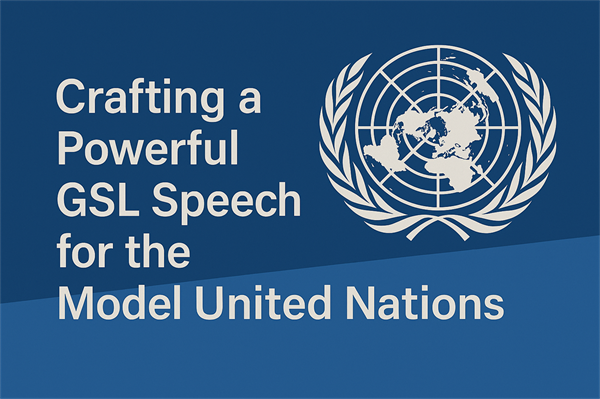How to Prepare for MUN Orientation: A Complete Guide
Model United Nations (MUN) is one of the most enriching experiences for students. It helps develop leadership, diplomacy, research, public speaking, and negotiation skills. However, before you step into a full-fledged MUN conference, attending an MUN Orientation is crucial. An orientation session is designed to introduce participants to the format, rules, and expectations of MUN. Preparing well for this orientation ensures that you begin your MUN journey with confidence and clarity.
In this blog, we will walk you through a step-by-step guide on how to prepare for your MUN orientation so that you make the most of it.
1. Understand the Purpose of MUN Orientation
The first step in preparing is knowing why orientation matters. Unlike the actual MUN conference, orientation is not about debating or passing resolutions. It is about:
-
Learning the structure of MUN sessions.
-
Understanding rules of procedure (ROP).
-
Knowing how to write a position paper and a draft resolution.
-
Practicing basic public speaking and diplomacy skills.
When you walk into orientation with this understanding, you’ll treat it as a learning platform rather than a competitive environment.
2. Familiarize Yourself with MUN Basics
Before attending, spend some time reading about the basics of MUN. Focus on:
-
What is MUN? → A simulation of the United Nations where students act as country delegates.
-
Committees → Examples include the UN General Assembly, UNHRC, or Security Council.
-
Delegates → Each student represents a country and voices its policies.
-
Key Documents → Position papers, working papers, draft resolutions.
This background knowledge ensures that you won’t feel lost when the orientation begins.
3. Research Your Assigned Country and Agenda
Most orientations provide you with a country and agenda beforehand. Even if it’s a practice session, researching your country will help you participate actively. Look for:
-
The geography, politics, and economy of your country.
-
Its foreign policy and alliances.
-
Its stance on the agenda topic. For example, if the agenda is climate change, find out whether your country supports renewable energy or relies heavily on fossil fuels.
Having this research will make your speeches and answers more authentic.
4. Learn the Rules of Procedure (ROP)
ROP is the backbone of MUN. During orientation, trainers will spend a lot of time explaining terms like motion for a moderated caucus, point of order, or general speakers’ list. To avoid confusion, read a simplified ROP guide beforehand. Pay special attention to:
-
The flow of debate → Roll call → GSL → Caucuses → Draft resolutions → Voting.
-
Points → Point of information, point of personal privilege, point of order.
-
Motions → Motion to set the agenda, motion for caucuses, motion to close debate.
This will help you follow along easily during the orientation.
5. Practice Public Speaking
MUN is not just about knowledge—it’s also about confidence. During orientation, you may be asked to give a short speech. To prepare:
-
Practice a 1-minute speech introducing yourself as your assigned country.
-
Record yourself speaking and notice your tone, clarity, and body language.
-
Use diplomatic language: Instead of saying “I think”, say “The delegation of [Country] believes”.
The more you practice, the less nervous you’ll be on orientation day.
6. Prepare a Mini Position Paper
Even if the orientation doesn’t require submission, writing a short position paper will help you structure your thoughts. A position paper usually includes:
-
Introduction to the issue.
-
Your country’s stance.
-
Past actions taken by your country.
-
Proposed solutions.
This exercise will help you understand how to back your arguments with facts and policies.
7. Engage Actively During Orientation
Preparation is only half the battle; the other half is participation. During orientation:
-
Ask questions whenever something is unclear.
-
Volunteer to give speeches or answer queries.
-
Take notes on rules, tips, and strategies shared by trainers.
-
Network with fellow delegates—building alliances starts here.
Active participation shows your enthusiasm and ensures you retain what you learn.
8. Reflect and Practice After Orientation
Your MUN orientation is not the end but the beginning. After the session:
-
Review your notes and practice the rules explained.
-
Work on areas where you felt less confident (ROP, speech-making, or resolution writing).
-
Attend mock MUNs or practice debates with peers to sharpen your skills.
Consistent reflection and practice will ensure that you’re well-prepared for the actual MUN conference.
Conclusion
Preparing for your MUN orientation is about building a foundation. By understanding the basics, researching your country, practicing speeches, and actively engaging during the session, you set yourself up for success. Remember, the orientation is a safe space to make mistakes, ask questions, and learn. Don’t be afraid to step out of your comfort zone. The more effort you put into your preparation, the more confident and impactful you will be in your MUN journey.


Comments
Post a Comment